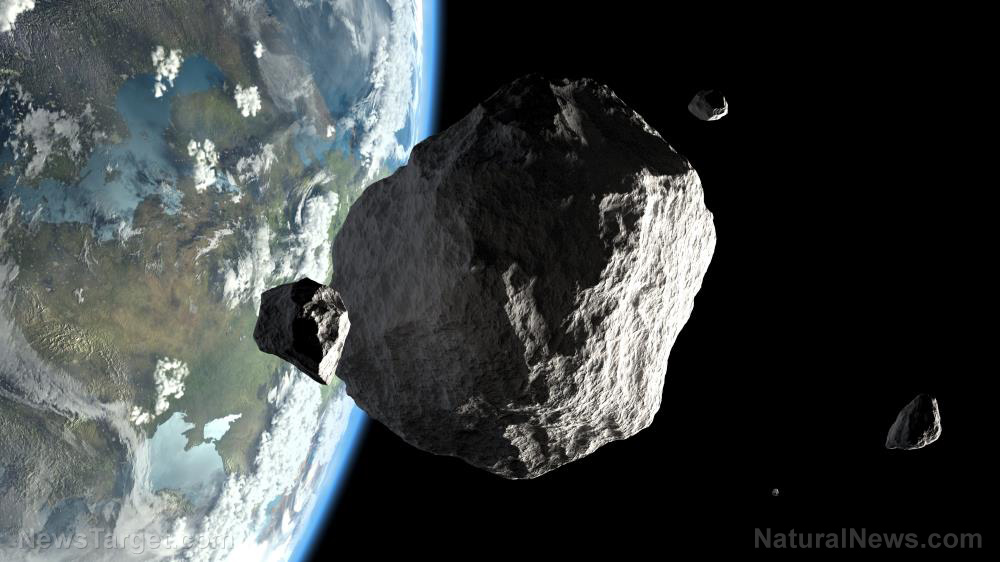Three asteroids will barrel past Earth before September ends
09/23/2020 / By Virgilio Marin

Astronomers are closely monitoring three asteroids that will barrel past Earth before September closes.
Two asteroids are set to blast past the planet within hours of each other on Sept. 25, according to the National Aeronautics and Space Administration (NASA) ’s Center for Near-Earth Object Studies. Meanwhile, an asteroid that could be as big as the Great Pyramid of Giza will make its closest approach on Sept. 29.
The three near-Earth objects (NEOs) are not on a collision trajectory to Earth. Such objects are closely monitored by NASA to assess hazard risk and prepare for a potential asteroid impact. However, not all asteroids that fly by or hit Earth are detected – one newly-discovered asteroid flew completely under the radar of major space agencies around the world. Instead, it was detected by an amateur astronomer.
Asteroids to hurtle past Earth
The first two space rocks are classified as an Apollo asteroid, which means they will cross Earth’s orbit as they travel through space. Asteroid 2020 RO is estimated to be up to 425 feet wide and will come closest to Earth past midnight. It will be followed 20 hours later by asteroid 2020 SM, which is up to 330 feet in diameter.
Although the two asteroids will come into contact with Earth’s orbit, NASA forecasts that they will not land on Earth. The same goes for asteroid 2020 PM7, which is estimated to be up to 655 feet wide.
The string of asteroidal activity comes after an amateur astronomer in Brazil, Leonardo Amaral, recently discovered an asteroid that’s more than half a mile in diameter. Asteroid 2020 QU6 came closest to Earth at about 24 million miles, which is 100 times the distance of the Moon from Earth.
Despite the vast distance, the discovery matters because it exposes the gaps in the strategies and technologies currently used for asteroid detection. For one, all of the world’s major asteroid sky surveys are performed in Earth’s northern hemisphere, which means that objects sneaking up from the south of the equator are more easily missed.
Moreover, about 90 percent of near-Earth objects (NEOs) that are at least a half a mile wide have already been found, reported the Planetary Society. The newly-discovered asteroid isn’t only a great addition to the current asteroid catalog. According to Casey Dreier, the chief advocate and senior space policy adviser for the Planetary Society, “This discovery reminds us that even though we’ve found most large NEOs, we haven’t found all of them.”
In August, an asteroid made the closest recorded fly-by to Earth. Asteroid 2020 QG was only the size of an SUV, which meant it would have had disintegrated in mid-air if it were on a collision trajectory. However, it was not detected until six hours after its closest approach. (Related: Fragments of a rare meteorite shower small Brazilian town.)
NASA to build space telescope for tracking asteroids
NASA will have the chance to improve its asteroid sky surveys and bolster planetary defense through the Neo Surveillance Mission, planned to be launched in 2025.
The mission will see the NEO Surveyor spacecraft in a Sun-Earth L1 halo orbit – a vantage point that’s mostly clear of the blind spots of a ground-based observatory. A telescope equipped with an infrared camera will be in the spacecraft to detect and track NEOs.
The project is based on NEOCam, a proposed new telescope that failed to see the light of day due to budgetary concerns. NEOCam has been in the works since Congress tasked NASA to identify all NEOs at least 460 feet in diameter. But it was competing for funding with other science projects at the time, leading to its shelving.
This time, the Neo Surveillance Mission has stronger Congressional support, thanks to a near-asteroid miss in the summer of 2019. Asteroid 2019 OK was the size of a football field and came 48,000 feet to Earth. It was only detected a day before its closest approach through a small telescope in Brazil.
Space.news has more on upcoming asteroid flybys and potentially dangerous NEOs.
Sources include:
Tagged Under: asteroid collision, asteroid detection, asteroids, disaster, Earth, NASA, near-Earth objects, outer space, planetary defense, Space, space telescope
RECENT NEWS & ARTICLES
COPYRIGHT © 2017 DISASTER NEWS

















